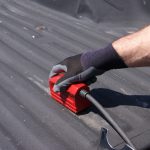CVW finds out more about induction heating technology. Alicia Hawkins, Marketing Manager for Induction Innovations, Inc. manufacturers of the INDUCTOR tools, provides a technical guide.
“Induction heating is used to bond, harden or soften metals or other conductive materials and offers an attractive combination of speed, consistency and control. Invisible, flameless heat is transferred to the product via electromagnetic waves, the part never comes into direct contact with any flame and the coil itself does not get hot.

“Electromagnetic induction is a magnetic flux through a surface bounded by the conductor. The solid-state RF power supply sends an AC current through a copper coil and the part to be heated is placed inside the coil. The coil serves as the transformer primary and the part to be heated becomes a short circuit secondary. When a metal part is placed within the induction coil and enters the magnetic field, circulating eddy currents are induced within the part. These eddy currents flow against the electrical resistivity of the metal, generating precise and localised heat without any direct contact between the part and the coil.”
The efficiency of an induction heating system for a specific application depends on several factors: the characteristics of the part itself, the design of the induction coil, the capacity of the power supply, and the degree of temperature change required for the application:

Metal or plastic parts
Induction heating works only with conductive materials, such as ferrous and some non-ferrous metals. Plastics and other non-conductive materials can often be heated indirectly by first heating a conductive metal susceptor which transfers heat to the non-conductive material.
Magnetic or non-magnetic materials
It is easier to heat magnetic materials. In addition to the heat induced by eddy currents, magnetic materials also produce heat through what is called the hysteresis effect. During the induction heating process, magnetics offer resistance to the rapidly alternating electrical fields, and this causes enough friction to provide a secondary source of heat. This effect ceases to occur at temperatures above the “Curie” point – the temperature at which a magnetic material loses its magnetic properties.
Thick or thin
With conductive materials, about 80% of the heating effect occurs on the surface or ‘skin’ of the part; the heating intensity diminishes as the distance from the surface increases. So small or thin parts generally heat more quickly than large thick parts, especially if the larger parts need to be heated all the way through.

Resistivity
If you use the exact same induction process to heat two same size pieces of steel and copper, the results will be quite different. Why? Steel – along with carbon, tin and tungsten – has high electrical resistivity. Because these metals strongly resist the current flow, heat builds up quickly. Low resistivity metals such as copper, brass and aluminium take longer to heat. Resistivity increases with temperature, so a very hot piece of steel will be more receptive to induction heating than a cold piece.
Induction coil design
The varying magnetic field required for induction heating is developed through the flow of alternating current in the coil. So, coil design is one of the most important aspects of the overall system. A well-designed coil provides the proper heating pattern for your part and maximizes the efficiency of the induction heating power supply, while still allowing easy insertion and removal of the part.









